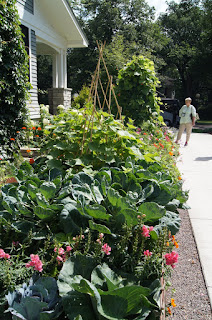 |
| Yellow and orange border at Lyndale Park Gardens |
Many of the gardeners who have invited us into their gardens are doing great work planting for pollinators. I was wowed by the garden of Rhonda Fleming Hayes, author of Pollinator Friendly Gardening. I especially loved the raised beds she filled with striking combinations of vegetables and ornamentals, a far cry from any vegetable garden I’ve ever imagined. Insects were happily buzzing and flitting around her lush plantings.
 |
| Rhonda's intensive mix of flowers and vegetables |
We toured gardens of Master Gardeners in Minnetonka. One of our hosts, Ruth, had done prodigious work clearing out buckthorn, a nonnative invasive shrub. She had planted native shrubs, trees and perennials that will soon fill in to make a paradise for native insects and other animals. We could already hear how happy the birds were in her yard.
Also on the tour was the garden of Laura and Steve, who maintain a piece of property behind their house as an unspoiled wetland to protect wildlife. Their yard was a shade garden after my own heart. I realized how soothing I find greens in different shades and textures, with a few flowers as accents. They too had chosen many native plants.
 |
| Subtle shade combination in Laura and Steve's garden |
Saturday night we heard a poignant talk by Peggy Anne Montgomery of American Beauties Native Plants, one of the sponsors of the Fling. Peggy Anne spoke about the threat to pollinators from pesticides and loss of habitat. She reminded us that we can help remedy this in our own gardens by planting some beautiful native plants.
Peggy Anne pointed out that lots of flowers can provide nectar and pollen for insects, but most insects are specialists that need particular host plants to eat and reproduce. A familiar example is monarch butterflies, which need milkweed. The adult females lay their eggs on milkweed plants, which the caterpillars need to eat.
 |
| A monarch at Vera's Garden, a community garden along the Midtown Greenway |
As Peggy Anne pointed out, without milkweed, there will be no monarchs. She urged us to plant host plants for native insects. Her talk will prompt me to think beyond flowers to insects’ other life cycle needs.
Tammy Schmitt, who blogs at Casa Mariposa, warned that annuals from garden centers can be permeated with commonly used insecticides called neonicotinoids. These are particularly toxic to bees. Tammy grows her own annuals from seeds to avoid bringing the neonicotinoids into her pollinator garden.
I’ll return home inspired to find more ways to make habitat for pollinators in my own garden. I’ll get some help from mountain mint (Pycnanthemum muticum), a gift from Peggy Anne and American Beauties Native Plants. Peggy Anne said she’s never seen so many insects attracted to one plant. I can’t wait to see what this plant will do in my yard.
No comments:
Post a Comment